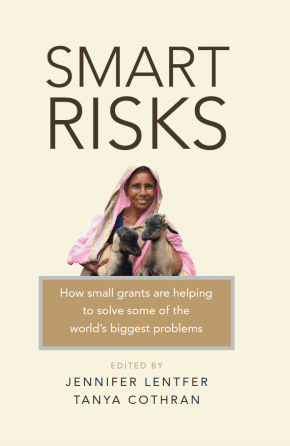 An excerpt from the introduction of the book Smart Risks: How small grants are helping to solve some of the world’s biggest problems, edited by myself and Tanya Cothran:
An excerpt from the introduction of the book Smart Risks: How small grants are helping to solve some of the world’s biggest problems, edited by myself and Tanya Cothran:
Often called “community-based organizations,” citizen-led groups that resemble parent-teacher associations, community garden projects, “save our shore” groups, or local independent media are active in every corner of the globe. The number and diversity of civil society actors in any one country is great. Among grassroots groups, there are tremendous wells of untapped potential. Yet despite their strengths, local organizations remain the lowest common denominator of international development assistance.
…People in rich countries don’t often hear stories about organized people improving their communities in the Global South or strong organizations pushing their governments to change policies that hurt poor people. Rather, the aid system is built on an assumption that outside experts have the knowledge, skills, and resources that are lacking in poor countries and communities. Also the aid system is predicated on marketing materials that show needy, desolate, and despondent individuals unable to help themselves, and so, the stories persist, even if they little resemble what is happening in reality, on the ground.
People involved in the social good sector often miss something important about organizations embedded in the communities they serve. Effective community leaders and nimble grassroots organizations know best how to operate in environments that rely on mutual responsibility and trust, rather than formal [Western] accountability measures.
Unfortunately limited exposure to international funders’ systems and expectations is a huge disadvantage for local groups with good ideas. The documentation required to pass administrative muster, to submit technical proposals and reports, is a huge disadvantage. As a result, local groups are often dismissed as being chronically mismanaged by people within the global development sector, rather than being judged by their embeddedness or results on the ground.
…Small grants to effective local organizations currently remain a very small part of the picture of global development. Luckily, there is a growing number of skilled intermediary funders adept at partnering with indigenous-led grassroots groups that demonstrate solid evidence of strong community ownership within their organizational systems.
Old-school approaches to international aid and philanthropy [as well as social enterprise and impact investing] miss out on the dynamism, innovation, and voluntary resources that community groups are able to generate. Indeed, when organizations are led entirely by people from the same communities they serve, they will remain in those communities, working on these issues, long after the international actors have left.
Smart Risks is available now!
Interested in hosting a book club, writing a review, including the book in your class, or featuring Smart Risks in your next event or conference? Please do be in touch!
***
Related Posts
Philanthropists, nonprofits need you to be brave
Why I wrote about “smart risks” in philanthropy and why I would frame it differently now
10 “big picture” communications questions for the social good sector
Getting real about dominant white culture
Does aid need a 12-step program?
